Are you seeing little white bumps in your skin? Are they hard to the touch? You may think it’s a whitehead or pimple, and try to squeeze it out of there but to no avail. Wondering what these bumps are? They’re called milia (milium if there’s just one) and they’re tiny, white, firm papules, which is the medical term for bumps. These annoying papules are actually small, superficial cysts just underneath the surface of the skin. They’re pretty common in babies — researchers say that up to 50 percent of newborns get them.
But people are susceptible to a milium cyst at any age. Milia can disappear on their own a lot of the time, and they’re not dangerous by any means, so you shouldn’t worry. But that, of course, doesn’t mean they aren’t annoying.
What are they and why are they the bane of your existence? Read on.
What are milia?
Put simply, milia are tiny (less than three millimeter) superficial cysts that form when skin cells (called keratin) become trapped instead of getting naturally sloughed off. The keratin gets lodged under a layer of protective skin tissue, a few cell layers thick.
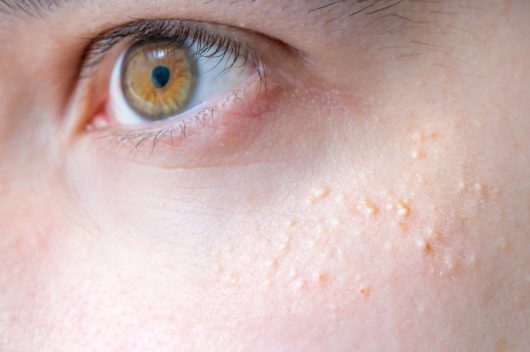
Milia aren’t usually itchy, they’re certainly not painful, but they can be annoying and can become irritated by rough fabrics. They can’t easily be popped because they are trapped just under the skin. This means that trying to pop or push them out just irritates the skin around them, which can increase your risk of skin infection and permanent scarring.
There are different ways of classifying milia, but they generally fall into these categories:
Congenital milia:
This is the type of milia that newborns have, and they usually appear on the face, scalp and torso. They generally clear up in a few weeks, but can also linger for several months.
Juvenile milia, or genodermatoses with milia:
These generally have a genetic component, and are linked to more than a dozen inherited conditions, such as Gardner syndrome and nevoid basal cell nevus syndrome.
Benign primary milia:
These guys appear on normal, healthy looking skin and are common in both kids and adults. They generally form on the eyelids, cheeks, forehead, and genitalia and can persist for months.
Milia en plaque:
A result of genetic or autoimmune skin disorders like lupus, these kind of milia affect the eyelids, ears, cheeks, or jaw. These larger, rare cysts tend to appear in middle-aged women most.
Multiple eruptive milia or nodular grouped milia:
You’ll find these on your face, upper arms, and upper trunk area. They’re basically groups of milia clustered together over time, and may itch.
Secondary milia:
These are trauma-associated milia and they usually occur in conjunction with some kind of skin injury, often while the body is healing. For instance, you’ll see this type of milia after laser resurfacing, a treatment that can soften fine lines, wrinkles, uneven pigmentation, and dark spots. Rarer medication-associated milia may also occur as a result of taking skin-based medications, such as hydroquinone or steroid creams.
Can you stop milia from forming?
The answer isn’t a straight yes or no, but you can make changes to your lifestyle and routine that may alleviate your milia. Usually, milia are the result of problems on the skin’s surface, but there’s typically more than one cause. Some causes, of course, are more preventable than others.
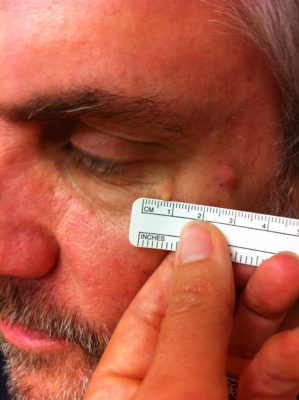 For one thing, putting heavy, occlusive products on your skin can coat the skin and inhibit the natural removal of dead skin cells. That includes everything from thick creams and ointments, to makeup and even lip balm. Using cleansing scrubs that contain beads may also increase the propensity for you to develop milia. So, if you’re noticing a lot of little white bumps, alter your beauty routine by making sure your skin care products are light, non-comedogenic, and not filled with harmful microbeads.
For one thing, putting heavy, occlusive products on your skin can coat the skin and inhibit the natural removal of dead skin cells. That includes everything from thick creams and ointments, to makeup and even lip balm. Using cleansing scrubs that contain beads may also increase the propensity for you to develop milia. So, if you’re noticing a lot of little white bumps, alter your beauty routine by making sure your skin care products are light, non-comedogenic, and not filled with harmful microbeads.
Milia are often associated with damage to the skin: blisters, burns, skin resurfacing procedures, and sun damage. So do what you’re supposed to do… lather on that SPF when you go outside!
Skin diseases, such as the blistering disorder porphyria cutanea tarda, may also be linked to milia. In babies, pores aren’t yet mature, which exacerbates the problem because those pores are easily irritated. For everyone else, keeping pores clear and clean can help prevent milia.
If these tricks don’t work, am I doomed?
No! Most of the time, milia bumps will disappear over time as the surface gets worn down, releasing the dead skin cells. It may take a few months, but don’t despair!
You can speed up the process using gentle exfoliators that contain chemical exfoliants such as alpha hydroxyl acids (AHAs) and beta hydroxyl acids (BHAs), or topical retinols.
Curious about what that means?
Check out our story all about understanding chemical-based facial scrubs!
Whatever you do, don’t scrub or pinch the cysts. Going down that road leads to infection and permanent scarring, so avoid it!
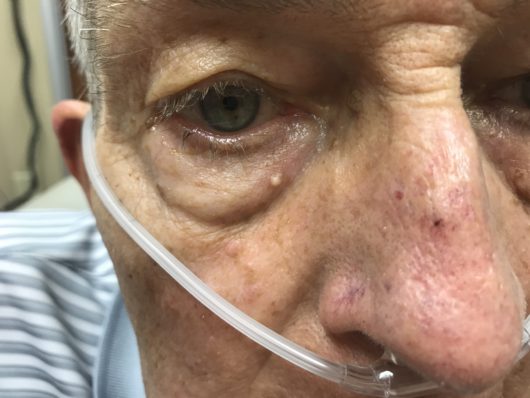
For the milia that have a genetic component, there’s not much you can do to stop them. But if you just want them gone, you can see your dermatologist. In fact, you should see a doctor anyway, just to rule out more dangerous skin conditions that may, especially in adults, look a bit like milia.
The doctor may do a simple evacuation by incising the milia, then extracting the tiny but firm pearl under the skin. Light electrocautery can also work for multiple . Chemical peels, laser surgery, and dermabrasion are also methods of removal. But don’t try these at home — especially on delicate the eyelid skin! — save these expert procedures for your dermatologist.



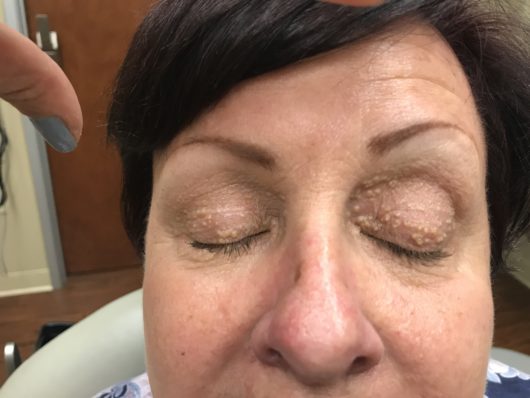
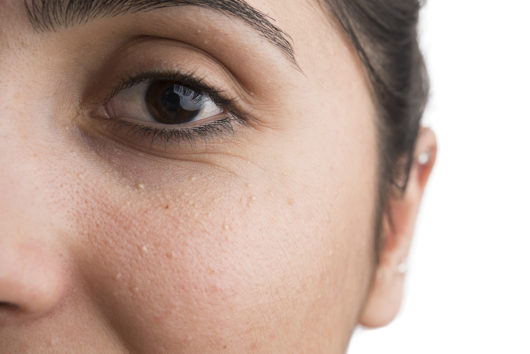


I am a sun worshiper and I had them for years before I figured out what they were. I am able to remove them by piercing the skin with a needle and popping them out. Some are more stubborn than others but I’m glad I can get rid of them myself. I always put sunscreen on my face, but it would seem that would clog your pores. So your damned if you do and definitely damned if you don’t.
This is so informative ! Thank you Dr. Lee! One question, at home would you recomend if a person try’s to remove the milia, using a blade?